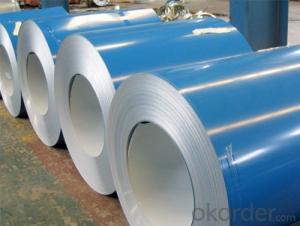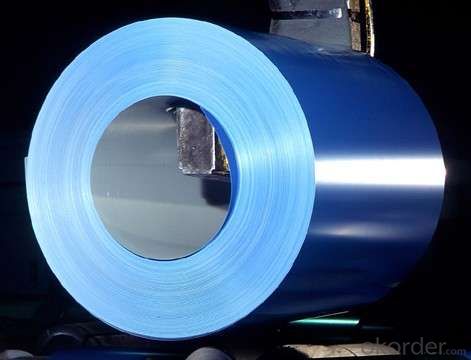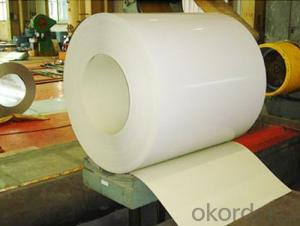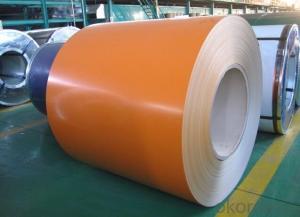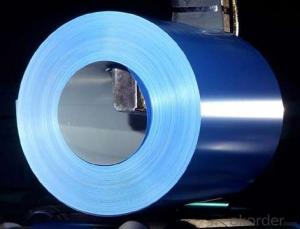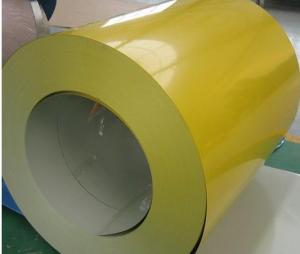PPGI Steel Sheet Coil with Nice Quality and Lowest Price Blue
- Loading Port:
- Tianjin
- Payment Terms:
- TT OR LC
- Min Order Qty:
- 222 m.t.
- Supply Capability:
- 11111 m.t./month
OKorder Service Pledge
OKorder Financial Service
You Might Also Like
1.Structure of Pre-painted Galvanized/Aluzinc Steel Coil Description
PPGI steel is good capable of decoration, molding, corrosion resistance.
It generally displays workability, durability and weather resistance.
2.Main Features of the Pre-painted Galvanized/Aluzinc Steel Coil
• good corrosion resistance
• perfect weather resistance
• Good formability
• Excellent corrosion resistance
• High strength
3.Pre-painted Galvanized/Aluzinc Steel Coil Images
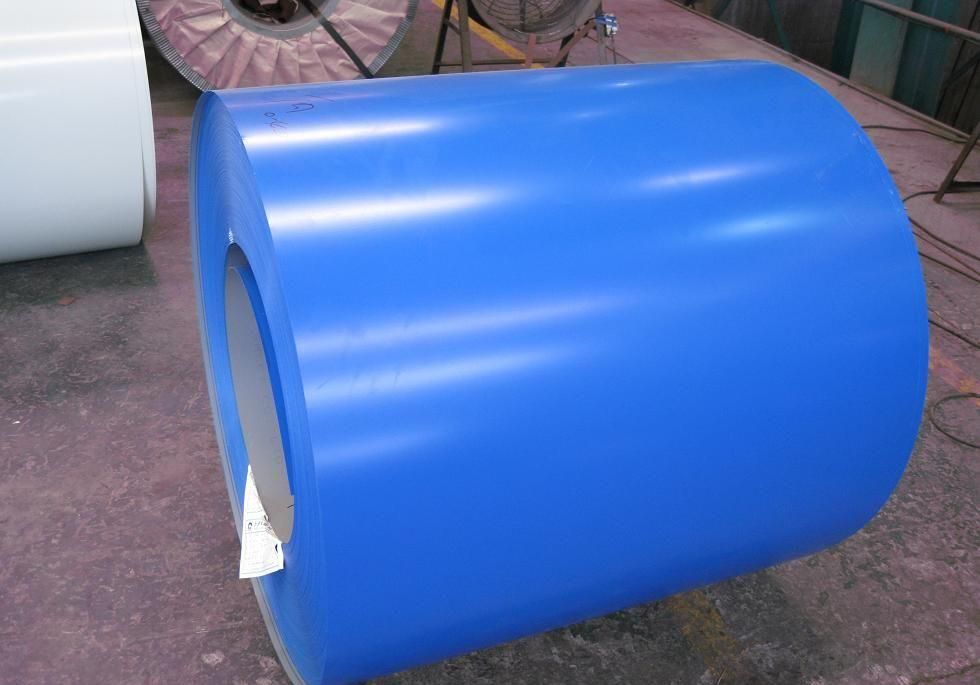
4.Pre-painted Galvanized/Aluzinc Steel Coil Specification
Paint thickness for top side : 5 micron primer + (10-20) microns modified polyester, any RAL color code.
Thickness : 0.14-1.20 mm
Width : 914mm, 1000mm, 1220mm and 1250mm, thickness 600-1250mm is available
Finish by coil or sheet: Both sheet and coil are available
Paint thickness for back side: (5-10) microns Epoxy
Weight per coil: 4-6 tons, also can be upon customer's requirements
Quality standar: JIS G3312 CGCC & CGLCC
Hardness of P: Both soft and hard quality are available
Surface finish: with or without protect film
8Zinc coating: 60-275G/M2, both sides
Max loading weight in one 20ft container : 25 tons generally
5. FAQ of Pre-painted Galvanized/Aluzinc Steel Coil
We have organized several common questions for our clients,may help you sincerely:
1. How to guarantee the quality of the products?
We have established the international advanced quality management system,every link from raw material to final product we have strict quality test;We resolutely put an end to unqualified products flowing into the market. At the same time, we will provide necessary follow-up service assurance.
- Q: How are steel coils used in the production of metal enclosures?
- Steel coils are widely used in the production of metal enclosures due to their versatility and strength. These coils, which are typically made from high-quality steel, serve as the primary raw material for manufacturing metal enclosures. Firstly, the steel coils are unrolled and flattened to the desired thickness using specialized machinery. This process ensures that the coils are in a suitable form for further processing. The flattened steel is then cut into specific sizes and shapes, depending on the design requirements for the metal enclosure. Next, the cut steel pieces are formed into the desired shape using various techniques such as bending, folding, and welding. These processes allow the steel to be molded into the required dimensions and structure of the metal enclosure. The inherent strength and durability of the steel coils ensure that the final product is sturdy and can withstand external forces or impacts. Additionally, steel coils can be coated with protective layers such as galvanization or powder coating to enhance their resistance to corrosion, rust, or other environmental factors. This coating helps to prolong the lifespan of the metal enclosure and maintain its aesthetic appeal. Moreover, the use of steel coils in the production of metal enclosures allows for customization and flexibility. The coils can be easily manipulated to create complex shapes or designs, enabling manufacturers to cater to specific customer requirements. This adaptability makes steel coils a preferred choice in industries such as automotive, electronics, and construction, where metal enclosures are widely used. In summary, steel coils play a crucial role in the production of metal enclosures by providing a strong and versatile raw material. These coils are transformed into the desired shape and size, ensuring the durability and functionality of the enclosures. With their customizable nature and protective coatings, steel coils offer a cost-effective solution for manufacturing high-quality metal enclosures.
- Q: What are the different types of steel coil coatings for corrosion resistance?
- Steel coil coatings can be classified into two main types: organic coatings and metallic coatings. 1. Organic coatings are commonly used for steel coil applications due to their excellent corrosion resistance and durability. There are four types of organic coatings: - Polyester coatings: These coatings offer good weatherability and resistance to chemicals, making them suitable for outdoor applications. - PVDF coatings: These coatings are highly resistant to UV radiation, weathering, and chemicals. They provide exceptional durability and are often used in demanding environments such as coastal areas or industrial settings. - Polyurethane coatings: These coatings offer excellent abrasion resistance and a high level of corrosion protection. They are commonly used in applications where there is a higher risk of mechanical damage or exposure to harsh conditions. - Epoxy coatings: These coatings provide excellent adhesion and chemical resistance. They are often used in industrial applications where resistance to chemicals, solvents, and oils is required. 2. Metallic coatings provide effective corrosion protection and can be further divided into two types: - Galvanized coatings: These coatings involve applying a layer of zinc to the steel surface through a hot-dip or electroplating process. This creates a barrier between the steel and the surrounding environment, providing effective corrosion protection. Galvanized coatings are widely used in various industries due to their cost-effectiveness and good durability. - Galvannealed coatings: These coatings are similar to galvanized coatings but undergo an additional heat treatment process. This results in a coating with increased hardness and improved paint adhesion, making it suitable for applications that require additional surface protection or paintability. When selecting the appropriate steel coil coating, it is essential to consider the specific requirements of the application and the level of corrosion resistance needed. Consulting with coating manufacturers or industry experts can help determine the most suitable coating for a particular application.
- Q: What are the main factors that affect the corrosion resistance of steel coils?
- The main factors that affect the corrosion resistance of steel coils include the composition of the steel, the presence of impurities, the surface finish, the environmental conditions, and the protective coatings applied to the steel.
- Q: What are the different types of steel coil processing equipment?
- There are several different types of steel coil processing equipment used in the manufacturing industry. These equipment are designed to handle and process steel coils in various ways, allowing for efficient and accurate production. Some of the common types of steel coil processing equipment include: 1. Decoilers: Decoilers are used to unwind steel coils and feed them into the processing line. They are equipped with motorized systems that control the unwinding process, ensuring a steady supply of material. 2. Straighteners: Straighteners are used to flatten and straighten steel coils that may have become distorted during the coiling process. They use a series of rollers to remove any bends or waves in the material, ensuring a smooth and consistent feed into the next processing stage. 3. Slitters: Slitters are used to cut steel coils into narrower strips, allowing for the production of various widths of steel sheets or strips. They consist of multiple sets of circular blades that can be adjusted to cut the desired width. 4. Levelers: Levelers are used to correct any surface imperfections in steel coils, such as wavy or undulating surfaces. They use a series of rollers to apply pressure and reshape the material, resulting in a flat and even surface. 5. Shears: Shears are used to cut steel coils into specific lengths. They can be hydraulic or mechanical and are designed to provide clean and precise cuts, ensuring the desired dimensions are achieved. 6. Recoilers: Recoilers are used to rewind processed steel coils back into a tightly wound coil. They can be motorized or manual and are essential for storage and transportation purposes. 7. Edge trimmers: Edge trimmers are used to remove any excess material from the edges of steel coils. They ensure a clean and uniform edge, allowing for better handling and further processing. 8. Coil cars: Coil cars are used to transport steel coils within the processing facility. They are equipped with hydraulic or mechanical systems that allow for easy loading and unloading of coils onto other equipment. These are just some of the different types of steel coil processing equipment used in the industry. Each equipment plays a crucial role in the manufacturing process, ensuring the efficient production of high-quality steel products.
- Q: What are the different methods of painting steel coils?
- There are several methods of painting steel coils, including coil coating, spray painting, and powder coating. Coil coating involves applying a liquid coating to the surface of the steel coil, which is then cured and dried. Spray painting involves using a spray gun to apply paint to the coil, typically in multiple layers. Powder coating involves electrostatically applying a dry powder to the coil, which is then cured and fused onto the surface. Each method has its advantages and is chosen based on factors such as durability, cost, and desired finish.
- Q: How are steel coils used in the production of metal cladding?
- Steel coils are used in the production of metal cladding as a primary raw material. Metal cladding refers to the process of covering a building's exterior with a layer of metal, typically steel, to enhance its durability, aesthetics, and insulation properties. Steel coils serve as the starting point for the manufacturing of metal cladding. These coils are typically made of galvanized steel, which is steel coated with a layer of zinc to protect it from corrosion. The coils are unrolled and fed into a roll-forming machine, where they are shaped into the desired profile for the metal cladding panels. Once the steel coils are formed into the required shape, they undergo various processes to enhance their properties. These processes may include cutting, perforating, and embossing to create patterns, textures, or openings in the cladding panels. The coils can also be coated with additional protective layers, such as paint or powder coating, to provide additional corrosion resistance and aesthetic appeal. The shaped and processed steel coils are then assembled into metal cladding panels. These panels are designed to interlock with each other, creating a seamless and visually appealing exterior for buildings. The panels can be attached to the building's structure using various methods, such as screws, clips, or adhesives. The use of steel coils in metal cladding production offers several advantages. Steel is a strong and durable material, making it suitable for exterior applications that require resistance to weathering, impact, and other environmental factors. Additionally, steel is highly versatile, allowing for a wide range of design options and customization. In conclusion, steel coils play a crucial role in the production of metal cladding. They serve as the raw material, which is shaped, processed, and assembled into panels that provide buildings with enhanced protection, aesthetics, and insulation properties.
- Q: How are steel coils stored in warehouses?
- Steel coils are typically stored in warehouses by stacking them securely on top of each other, either directly on the warehouse floor or on specially designed racks. They are often stored vertically to save space and ensure stability. Additionally, to prevent damage and corrosion, steel coils are often wrapped in protective materials or placed on pallets.
- Q: How are steel coils cleaned?
- Steel coils are typically cleaned using a combination of mechanical and chemical methods. First, the coils are subjected to high-pressure water jets to remove any loose dirt, dust, or debris. Then, a specialized cleaning solution or detergent is applied to dissolve and remove any oil, grease, or stubborn stains. The coils are rinsed thoroughly to ensure the removal of all cleaning agents, followed by drying to prevent corrosion.
- Q: Why are steel saucepans and tea kettles covered with copper on the outside and the bottom? what r the goals of having high-quality pans that are thick and tea kettles that are thin walled?
- Stainless steel is less conductive than copper. However, steel will retain heat longer and thus be distributed more evenly. (hence the thick bottoms, but also for balance). Copper on tea kettles is ideal to bring water up to a boil rapidly but since your not really cooking food, temperature distribution or control doesn't really matter. Now if your cooking sensitive food, then it does matter. For example, the use of a double boiler is preferred for chocolates. Temperature and distribution is critical. As far as relatively inexpensive copper clad pots and pans such as Revereware? Well, I don't see a difference but perhaps they did some testing.
- Q: I know that steel wool is coated with... something... that protects it from rusting. I need to know what that is, and how to get it off.
- It will be very effective if you remove the oil by appling protective polymer spin coating to the edge, top and underside of the wafer, which makes those surfaces impervious to most chemical etchants. To learn more about the spin coating theory you may check out the following source.
Send your message to us
PPGI Steel Sheet Coil with Nice Quality and Lowest Price Blue
- Loading Port:
- Tianjin
- Payment Terms:
- TT OR LC
- Min Order Qty:
- 222 m.t.
- Supply Capability:
- 11111 m.t./month
OKorder Service Pledge
OKorder Financial Service
Similar products
Hot products
Hot Searches
Related keywords
